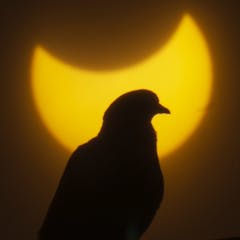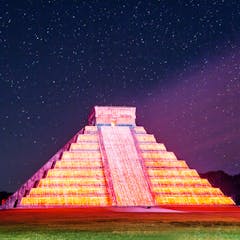
Articles on Solar eclipse
Displaying 1 - 20 of 54 articles

Analysis of fragments of the first solids that emerged out of the birth of the sun date our supernova as being 4.6 billion years old.

To protect their kings, ancient Mesopotamians discovered how to predict eclipses, which were associated with the deaths of rulers. This eventually led to the birth of astronomy.

Eclipses have long fascinated and intrigued people, and anticipation of the total solar eclipse on April 8 is no exception. The beauty, history, mythology and science of eclipses justify the hype.

A total solar eclipse is a beautiful phenomenon worth seeing, but worth seeing safely.

Since an eclipse only lasts a few minutes, you need more than just a handful of scientists running around collecting data on bird activity. That’s where a new app comes in.

Medieval scholars connected celestial events to changes that happened on the ground, such as the overthrow of the king.

The sky is becoming more cluttered with satellites and space junk. This is affecting astronomical study, but will only have a minor effect — if any — on the viewing of the solar eclipse.

A million people are anticipated to head to the Niagara Region to experience the total solar eclipse on April 8. Keeping large crowds of spectators safe may pose a challenge for the region.

The skies and the gods were inseparable in Maya culture. Astronomers kept careful track of events like eclipses in order to perform the renewal ceremonies to continue the world’s cycles of rebirth.

Observations during historical solar eclipses confirmed Einstein’s theory of gravity, and led to the predictions of black holes.

Your phone can’t take a perfectly clear picture of a solar eclipse like a professional camera can, but there are lots of other creative directions you can take to capture the rare moment.

The solar corona can be seen during the solar eclipse on April 8. Astronomers are still trying to figure out the mysteries of the corona, including why it’s so hot.

The eclipse will allow scientists to get rare measurements of the Sun’s atmosphere.

Apart from technical aspects, a successful photograph of the eclipse serves as a lasting reminder of the sense of wonder and the feeling of being part of something larger than ourselves.

If you have young kids, the solar eclipse on April 8, 2024, represents a rare opportunity to teach them about science.

A lunar eclipse ceremony from the Torres Strait turns our understanding of the history of science on its head.

Eclipses are rare, fantastic celestial events. Here’s how educators can help visually impaired students enjoy eclipses alongside their sighted peers.

Don’t skimp on your eye safety.

Eclipses have inspired myths, predictions and scientific discoveries. The total solar eclipse occurring on April 8 provides a once-in-a-lifetime opportunity to engage with science and the cosmos.

Many people will see a dazzling eclipse this April, but these events are possible only because of the sizes and precise distances between Earth, the Moon and the Sun.
